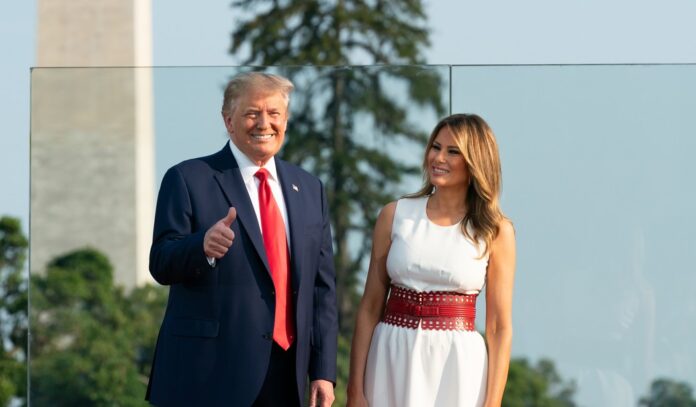President Donald J. Trump‘s announcement on abortion policy was the obvious culmination of the president’s fight to protect the unborn and restore federalism to a Washington-centric political system—it also served as a reminder that Trump is the most pro-life president in American history.
Trump’s three Supreme Court-appointed justices, Neil M. Gorsuch, Brett M. Kavanaugh, and Amy Coney Barrett, were the backbone of its June 24, 2022, Dobbs v. Jackson Women’s Health Organization, which removed the federal government from governing abortion rights.
When Trump announced he supported the federalist position, having abortion laws decided by the states, he was ripped as betraying conservatism.
Put in the context of other Republican presidents in the post-Roe era, Trump’s record tells a different story.
Throughout American history, abortion was regulated by the states, and it was not the province of the federal government until the Supreme Court announced its Jan. 22, 1973, Roe v. Wade decision, which preempted state abortion laws.
Because pro-abortion forces focused on the federal courts, leading to the high court, rather than through the state legislatures or Congress, the best way to judge a president’s pro-life record is to examine their Supreme Court appointees and how they dealt with abortion rights.
For this piece, the focus is on Republican presidents, which puts Trump in context with other GOP chief executives.
Also, this lookback does not address Supreme Court gamesmanship, such as when Senate Republicans acquiesced to President William J. Clinton nominating Stephen G. Breyer to the Supreme Court in the summer of 1994—roughly three months before Republicans picked up eight seats and took over the upper chamber.
Breyer was a pro-abortion vote on the Supreme Court for the next 18 years.
Beginning in 1969 and ending in 2020, Republican presidents have put 15 justices on the Supreme Court. Eight have been pro-abortion, and seven have been pro-life—three of them put on the high court by Trump.
In the same time frame, Republican presidents have nominated all three chief justices, Warren E. Burger, William H. Rehnquist, and John G. Roberts Jr.—both Burger and Roberts were pro-abortion.
Roberts was nominated to the court by President George W. Bush to replace the retiring Sandra Day O’Connor. When Rehnquist died, Bush promoted Roberts to chief justice and nominated pro-life Samuel A. Alito Jr. to fill the new slot.
As it often happens, Roberts’ abortion positions were a disappointment to Bush. During the Roberts confirmation, a member of the confirmation team told me that a senior Federalist Society member took Roberts to lunch to ascertain if Roberts was pro-life. When the answer was yes, the White House went forward.
Republican appointee wrote Roe v. Wade decision
After he left the White House, President Dwight D. Eisenhower is supposed to have said: “I have made two mistakes, and they are both sitting on the Supreme Court.”
Ike was referring to Justice William F. Brennan Jr. and Chief Justice Earl Warren, both of whom voted with the majority in the case that was the harbinger of the federal role: the 1965 Griswold v. Connecticut decision that overturned the Nutmeg State’s ban on contraceptives.
Contrary to the conventional wisdom that Democrats have dominated the Supreme Court, beginning with Warren, there has been a GOP-appointed chief justice from 1953 to the present.
Griswold was a hallmark in the legal hermeneutics theory that holds that the Constitution has unenumerated rights, which are not stated overtly in the text but can be divined and proclaimed by justices as having the same weight as the rights actually written by the Framers or in the subsequent amendments.
Eight years later, the right to privacy the justices discovered in Griswold was the foundation of the Roe decision, which claimed to have found a right to abortion in the Constitution, hiding between the lines.
In addition to Burger and Rehnquist, Nixon put Lewis F. Powell Jr. and Harry A. Blackmun on the high court. In 1986, Rehnquist was promoted to chief justice by President Ronald W. Reagan.
Before Powell retired from the court in 1987, the pro-abortion justice voted in the majority in each of the 18 Supreme Court abortion-related decisions during his tenure, including Roe.
Three of Nixon’s justices, Burger, Powell, and Blackmun, voted with the 7-2 Roe majority, and Blackmun wrote the majority opinion.
Republican nominees provide all five majority votes in the 1992 Casey decision
After Griswold, conservative legal scholars and jurists recognized that if they accepted the concept of unenumerated constitutional rights, the Constitution would be dethroned, and liberals on the high court would have a blank check to do whatever they wanted.
The response to the advocates for unenumerated rights was the strict constructionist movement, which was committed to the text as it was written and understood as it was written.
Although Burger voted with the Roe majority, Nixon chose Burger because of his reputation as a strict constructionist, just as he chose Rehnquist.
By 1992, all the judicial momentum was with the strict constructionists, but that was not strictly reflected in the GOP Supreme Court nominees.
President Gerald R. Ford nominated pro-abortion Justice John Paul Stevens in 1975.
Reagan, who signed the 1967 California law legalizing all abortions before 20 weeks, put pro-abortion justices Sandra Day O’Connor, 1981, and Anthony M. Kennedy, 1988, on the high court, but also the pro-life Antonin Scalia, 1986.
President George H.W. Bush put pro-abortion Justice David H. Souter on the court in 1990 and pro-life Justice Clarence Thomas on the court in 1991.
After nearly 12 years in the White House, the Republican Party, which became the pro-life party in 1980, led by Reagan, who had been converted to the pro-life position by Dr. Mildred Jefferson, determined it was time to make a pro-life assault at the Supreme Court.
The vehicle for that assault was the Planned Parenthood v. Casey case. Casey was Pennsylvania Democratic Gov. Robert P. Casey, and Planned Parenthood was challenging a Keystone State abortion law requiring parental consent for girls under 15, notification of husbands, and a 24-hour waiting period.
It is hard to exaggerate the confidence conservatives had going into Casey. In addition to the intellectual momentum of the strict constructionists, eight of the nine justices were GOP appointees.
The only Democratic appointee on the high court was Justice Byron R. White. White, who joined Rehnquist dissenting in Roe, was appointed by President John F. Kennedy in 1962, and he remained pro-life throughout his tenure on the court.
Conservatives had every expectation the Supreme Court would uphold the Pennsylvania law, overturn Roe, and once and for all put the unenumerated rights theory back in the box.
What happened, of course, was less than ideal. Instead of obliterating Roe, five of the justices used Casey to buttress the abortion rights created in the 1973 ruling. Three of the GOP justices, O’Connor, Kennedy, and Souter, co-wrote the majority opinion.
An O’Connor staffer, who remained close to the justice into her retirement, once told me that she created the viability standard, a swap for Roe’s focus on trimesters, with the intention of eventually closing the legal time frame for abortion—relying on medical advances to achieve what conservatives could not achieve politically nor judicially.
Be that as it may, the capstone of 12 years of Republican control of the executive branch and six years of controlling the Senate ended with abortion rights in a stronger constitutional position than ever before.
Trump’s SCOTUS delivers Dobbs, obliterates Roe, Casey
Every Republican presidential candidate, beginning with Nixon in 1968, has promised voters that he was going to nominate conservatives to the Supreme Court. In the post-Roe era, the Supreme Court has become the surrogate for the fight to restore legal protection to the unborn.
Trump was no exception, but more so.
Edison Media Research exit polling found that the Supreme Court was the most important issue for 26 percent of Trump voters, and CNN exit polling found the same for 56 percent of Trump voters.
Trump’s 2016 victory came 43 years after Roe, 36 years after the GOP promised to overturn Roe, and 24 years after Casey. For all of the promises and rhetoric, five Republican presidents failed to make any dent into the so-called constitutional right to an abortion.
To be fair, there have been attempts, and there were four pro-life justices before Trump.
Part of the problem was Republican nominees’ unwillingness to discuss or even acknowledge the Roe and Casey rulings, coupled with their eagerness to affirm the power of precedent.

One astonishing exception was Alito.
When the author of Dobbs‘ majority opinion testified in his 2006 confirmation hearings, he did not accept precedent as set in concrete.
This was flushed out by Alito’s interactions with Delaware Democratic Sen. Joseph R. Biden Jr. regarding abortion and the Supreme Court, Scalia’s Casey dissent, and stare decisis, the Latin phrase for court rulings respecting the precedent of previous rulings.
“Scalia said in the abortion case, he said: ‘Look, we should just look at this head-on. Roe v. Wade is wrongly decided, and we should just say so,'” the senator said.
“He’s entitled to do that, and if he had a majority,” Biden said.
“I’m not suggesting what you would do on that — he’s entitled to do that — and that wouldn’t be a violation of any written or unwritten code that relates to Supreme Court Justice’s conduct, would it?” he asked.
Instead of deflecting, Alito engaged with Biden.
“In the area of constitutional law,” Alito said. “There has to be the ability to revisit a case like Plessy v. Ferguson. I don’t think anybody would want a system of stare decisis that made that impossible.”
The 1896 Plessey SCOTUS decision ruled that accommodations could be segregated by race as long as they were equal. It was rendered moot by the 1954 Brown v. Board of Education decision.
Biden’s point that precedent is meaningless as long as you have the votes was one Alito took to heart.
Alito’s Dobbs opinion was leaked in May 2022, unleashing the whirlwind.
My RedState colleague Becca Lower covered the Dobbs leak in her piece: “Justice Alito: SCOTUS Dobbs Leak Was Caused by Those Who Wish to Politicize Court.”
When the decision was posted a month-and-a-half later, at the end of the high court’s session, it was virtually unchanged from what was leaked, which suggests that infighting held the ruling back until the last minute.
A number of media reports described how Roberts fought with the conservative justices to restrain Dobbs so that it was so narrow it did not alter the constitutional right to an abortion.
My RedState colleague Streiff discussed what we learned about Roberts post-Dobbs in his article: “The Decision to Overturn Roe Shows That Chief Justice John Roberts Has Lost the Confidence of the Court’s Conservative Majority.”
The chief justice’s principal power, aside from his control of the high court’s staff and administration, is his right to assign the writing of the majority opinion if he is in the majority.
In 2020, he was the fifth vote when the court struck down a pro-life Louisiana law that would have required abortion doctors to have admitting privileges at a hospital. Although it was not an outright ban, the law would have made it more difficult for abortion doctors to operate in the state — and it could have been the vehicle to overturn the Casey regime.
This pivot to join the Democratic-appointed justices was possible until Barrett joined the court to fill the vacancy created by Justice Ruth Bader Ginsburg’s passing.
Faced with three Trump pro-life justices, plus Alito and Thomas, the conservatives had the five votes they needed, so if Roberts wanted to influence the decision at all, he had to make the vote 6-3.
Two years into the post-Dobbs era, the pro-life movement is still trying to figure out its next steps. Pro-abortion activists are motivated, and they are aggressively pushing referenda and candidates.
The action is now in the states after 50 years in Washington, generally, at the Supreme Court, specifically.
Some people in the pro-life movement sound like Cold War veterans complaining that the Berlin Wall and the Soviet Union fell, but the fact remains that Roe and Casey are gone — and Trump made it happen.
For all the recent triumphalism of the pro-abortion movement, none of them like what Trump did to them — and for the unborn.




